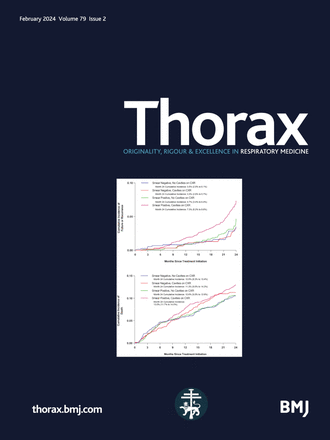Antimicrobial resistance in chronic lung infection: the road to resistance
IF 7.7
1区 医学
Q1 RESPIRATORY SYSTEM
引用次数: 0
Abstract
Background Antimicrobial resistance (AMR) is a growing global health crisis and is particularly relevant to people living with chronic lung diseases such as bronchiectasis, cystic fibrosis and chronic obstructive pulmonary disease. These conditions frequently involve acute and chronic bacterial infections, requiring increased antibiotic usage and risk of AMR. Understanding the dynamics of AMR and emerging diagnostic and therapeutic strategies is crucial for optimising patient outcomes in this setting. Aims This review explores the interplay between AMR and chronic bacterial lung infections, examining current understanding of pathogen epidemiology, diagnostic strategies, clinical implications of resistance and the impact of treatments. Future directions in research and therapeutic innovation are also outlined. Narrative Key pathogens in chronic lung infections, such as Pseudomonas aeruginosa , Haemophilus influenzae , Staphylococcus aureus and Moraxella catarrhalis , exhibit diverse resistance mechanisms and AMR is linked to increased disease severity, exacerbation frequency and mortality, particularly with multidrug-resistant strains. Long-term antibiotic therapies, such as macrolides and inhaled agents, improve clinical outcomes but may drive resistance, necessitating ongoing efforts to understand how they can best be employed. Traditional diagnostic methods, such as culture-based antimicrobial susceptibility testing, often fail to capture the complexity of polymicrobial infections and resistomes. Although advanced techniques like next-generation sequencing and metagenomics are able to identify clinically relevant resistotypes, their development toward clinical utility is still in progress. Conclusions AMR in chronic lung infections represents a dynamic and multifaceted challenge. Novel antibiotics, precision medicine approaches and alternative therapies such as bacteriophages show promise but require further validation. Improved stewardship and individualised treatment strategies are critical for mitigating AMR and enhancing patient outcomes. Collaborative efforts among researchers, clinicians and policy-makers are vital to advancing care and combating this global threat.慢性肺部感染中的抗菌素耐药性:通往耐药性之路
抗微生物药物耐药性(AMR)是一个日益严重的全球健康危机,与支气管扩张、囊性纤维化和慢性阻塞性肺病等慢性肺部疾病患者尤其相关。这些情况通常涉及急性和慢性细菌感染,需要增加抗生素的使用和抗菌素耐药性的风险。了解抗菌素耐药性的动态和新兴的诊断和治疗策略对于优化这种情况下的患者预后至关重要。本综述探讨了AMR与慢性细菌性肺部感染之间的相互作用,检查了目前对病原体流行病学,诊断策略,耐药的临床意义和治疗的影响的理解。展望了未来的研究方向和治疗创新。慢性肺部感染的主要病原体,如铜绿假单胞菌、流感嗜血杆菌、金黄色葡萄球菌和卡他莫拉菌,表现出多种耐药机制,耐药耐药性与疾病严重程度、恶化频率和死亡率增加有关,特别是与多重耐药菌株有关。长期抗生素治疗,如大环内酯类药物和吸入药物,可以改善临床结果,但可能会导致耐药性,因此需要不断努力了解如何最好地使用它们。传统的诊断方法,如基于培养的抗微生物药敏试验,往往无法捕捉到多微生物感染和抗性组的复杂性。虽然新一代测序和宏基因组学等先进技术能够识别临床相关的耐药型,但它们在临床应用方面的发展仍在进行中。结论慢性肺部感染的AMR是一个动态的、多方面的挑战。新型抗生素、精准医疗方法和替代疗法(如噬菌体)显示出希望,但需要进一步验证。改进管理和个性化治疗策略对于减轻抗菌素耐药性和提高患者预后至关重要。研究人员、临床医生和决策者之间的合作努力对于推进护理和抗击这一全球威胁至关重要。
本文章由计算机程序翻译,如有差异,请以英文原文为准。
求助全文
约1分钟内获得全文
求助全文
来源期刊

Thorax
医学-呼吸系统
CiteScore
16.10
自引率
2.00%
发文量
197
审稿时长
1 months
期刊介绍:
Thorax stands as one of the premier respiratory medicine journals globally, featuring clinical and experimental research articles spanning respiratory medicine, pediatrics, immunology, pharmacology, pathology, and surgery. The journal's mission is to publish noteworthy advancements in scientific understanding that are poised to influence clinical practice significantly. This encompasses articles delving into basic and translational mechanisms applicable to clinical material, covering areas such as cell and molecular biology, genetics, epidemiology, and immunology.
 求助内容:
求助内容: 应助结果提醒方式:
应助结果提醒方式:


